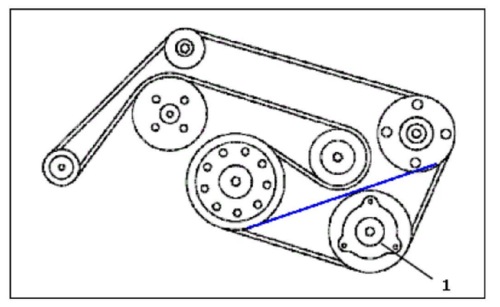Applicable Vehicles:
Model 163.154/157/172/174/175
Model 164.172/175/186/871/886
Model 171.454/456/473
Model 203.052/054/056/061/064/065/081/084/ 087/092/261/264/281/284
Model 209.356/365/372/375/456/465/472/475
Model 211.056/065/070/072/082/083/087/ 090/256/265/282/283/287
Model 215.373/374/375
Model 216.371
Model 219.372/375
Model 220.170/173/174/175/183/184
Model 221.171/186
Model 230.471/472/475
Model 251.156/165/175
If you receive customer reports in the above model vehicles of grinding or gushing noises, which may be heard from the area of the steering system/power steering pump, one of the possible causes may be in the A/C compressor belt drive.
This noise is similar to the noise produced by the power steering pump when ingesting air. This type of noise is present at both idle and higher engine speeds, can be heard whether the steering wheel is stationary or moving, and the noise frequency increases with the engine speed. The noise intensity increases toward steering wheel end limit stops.
Note: The noise does not change by switching the A/C compressor on and off. Evacuating the refrigerant will not change the noise since the A/C compressor belt pulley runs continuously with the engine.
Note: Do not replace the A/C compressor belt pulley merely on suspicion. To determine whether the noise is caused by the A/C compressor, perform the following test using a shorter poly-V-belt. It is absolutely essential to follow in sequence the below procedure:
1. Detach the original poly-V-belt.
2. Install poly-V-belt P/N A011 997 96 92 on vehicles with M112/M113 engines or install poly-V-belt P/N A011 997 04 92 on vehicles with M272/M273 engines. With the shorter belt installed, the A/C compressor is not driven by the belt. (The A/C compressor pulley is by-passed.) Route the rest of the belt the same way as the original belt. See Fig. 1.

3. Start the engine and listen for the complaint noise.
4. If the complaint noise is no longer present, replace the A/C compressor belt pulley. Refer to the latest version of DTB P-83.55/87 for A/C compressor poly-V-belt pulley replacement.
5. If the complaint noise is still present, it is not due to the A/C compressor. Therefore, resolve the noise issue by following the procedure in Star TekInfo > EDAC > Diagnostic Guides > Power Steering Diagnostic Guide (latest version) > Start > Noises in steering system.
6. Reinstall the original belt.
Courtesy of Mitchell 1.












